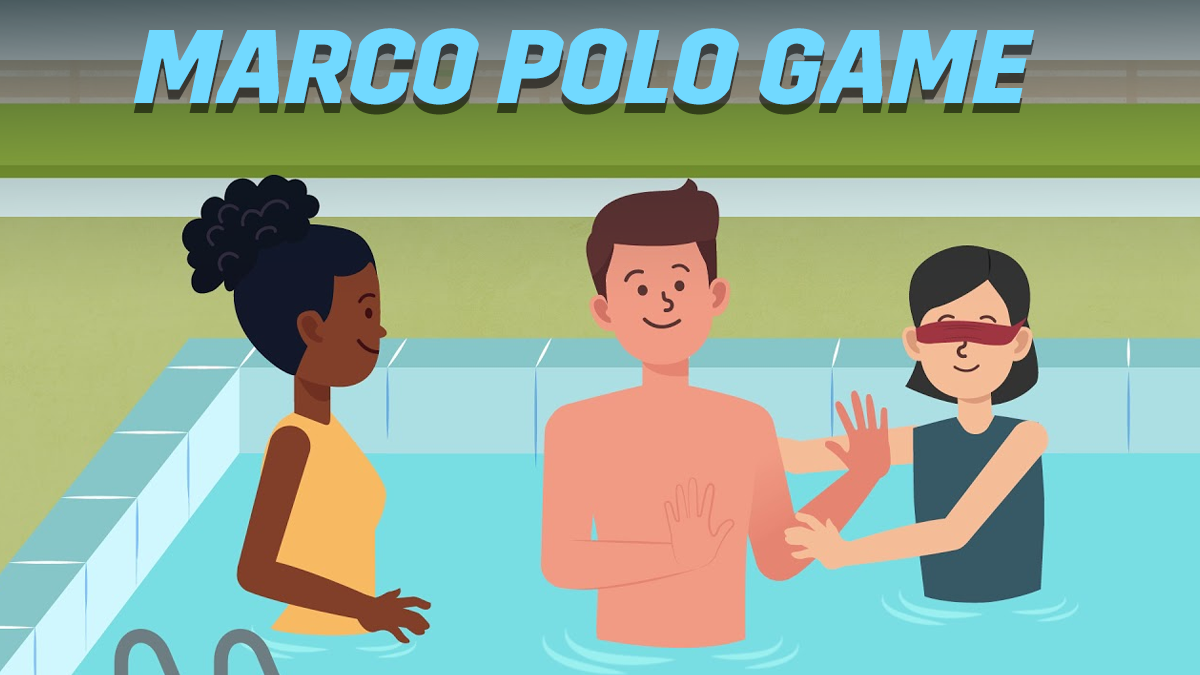Table of Contents
ToggleIf you’ve ever spent time at a swimming pool during the summer, chances are you’ve heard someone shout, “Marco!”—only to be met with an echoing, “Polo!” It is the Marco Polo game. The popular pool game has been a staple of poolside fun for generations. But where did it come from? And how exactly do you play it?
Let’s break down everything you need to know about the Marco Polo game, from its origins to its simple yet exciting rules. You may be looking to introduce it to a group of first-time players or just brush up on the game before your next pool party; you’re welcome.
What is Marco Polo Game?
Marco Polo is a water-based tag game that’s been a favorite among kids and families for decades. The game name honors the Venetian merchant and adventurer Marco Polo, who was known for his adventurous spirit. It shares some traits with another game, “Blind Man’s Buff.”
It’s played in a swimming pool. One person closes his or her eyes and calls out “Marco,” while other players respond with “Polo.” The goal? The “it” player must use only sound cues to locate and tag other players.
Though the game is often associated with children, it’s a great activity for people of all ages. Its simplicity and reliance on listening skills make it challenging and endlessly fun.
How to Play Marco Polo Game in a Pool
Marco Polo is traditionally a popular pool game, though it can be adapted to land. We’ll focus on how to play marco polo game in a pool. Each game naturally lasts 10-20 minutes before players switch roles or take a break.
Objective
The main objective of Marco Polo is for the “it” player to locate and tag other players using only sound cues. The “it” player, with closed eyes, must rely on their sense of hearing to pinpoint the location of the other players, who try to avoid being tagged while staying within the pool’s boundaries. The game continues until all players are tagged or the group decides to switch roles.
Setup
- Gather Players: You’ll need at least three participants. The more, the better.
- Choose the “It” Player: One person is designated as “it.” That player will start the game by closing their eyes.
- Set the Boundaries: Establish the area where players can move. The entire pool is fair game, but you may want to limit movement for safety, especially in larger pools.
- Set a Timer (Optional): To keep the game fair and engaging, you can use a timer. Set a limit for how long one player can be “it”—for example, 3 to 5 minutes. If they don’t tag anyone within the time limit, another player can take over as “it.” After all, no one wants to stay “it” for too long!Using a timer also prevents a bullying situation, where a weak player may be forced to be the “Marco” for a long time.
Marco Polo Game Rules
- Start the Game: The “it” player closes their eyes and counts to 10 while the other players spread out in the pool.
- Calling “Marco”: The “it” player must keep their eyes closed at all times and call out “Marco!” repeatedly.
- Responding with “Polo”: The other players must answer with “Polo,” giving the “it” player an audio cue to locate them.
- Penalty for Silence: If the “it” player suspects someone is staying silent above water instead of responding with “Polo,” they can call them out by name. If other players agree, that person becomes “it.” The game starts all over again.
The only exception is when a player is underwater, unable to shout.
- Tagging Opponents: The “it” player moves around the pool, listening carefully and trying to tag another player. It is advised to keep hands out while moving for safety.You can decide what counts as a tag in the game. Does Marco have to touch someone with their hands, or does any contact—like a light brush from a leg—count as a tag?
- No Peeking: The “it” player must keep their eyes closed unless they step out of the water (to prevent cheating).
- Land Rule: If a player climbs out of the pool to avoid being tagged, the “it” player can call out “Fish out of water!” If caught, the person outside the pool becomes the new “it.”
- Switching Turns: When the “it” player successfully tags someone, that person becomes the new “it,” and the game restarts.
Who’s the Winner?
As you can see, there’s a winner for every round. If the “It” player is able to tag another player during his turn, he succeeds in the round. So, there’s no one winner in the game. But if you want, you can designate a single winner by playing multiple rounds. The player who can tag the most number of times, during multiple rounds, can be declared a winner.
If you’re using a timer, play multiple rounds and see which player tags the fastest. Declare them as the final winner.
Marco Polo game rules are very adaptable!
How Marco Polo Helps Children?
- Improves listening skills by requiring players to focus on sound cues.
- Enhances spatial awareness as children detect movement and positioning without sight.
- Encourages social interaction and communication skills through teamwork and turn-taking.
- Develops problem-solving skills as players try to avoid being tagged.
- Strengthens gross motor skills like swimming, running, and quick movement.
- Teaches rule-following and fair play.
Yup! The game also promotes physical activity, reducing screen time. Regular play can even kindle the adventurous spirit in children.
Tips for a Fair Game
To keep the game enjoyable and fair for everyone, consider these tips:
- Stick to the Boundaries: Make sure everyone stays within the designated playing area.
- Encourage Honesty: No peeking or refusing to say “Polo.”
- Use a Timer: Set up a time limit so there’s fair play. It also prevents a bullying situation, where one player might end up as “Marco” frequently.
- Be Aware: Avoid running near the pool’s edge to prevent slips and falls.
- Use a Safe Pace: Players should swim at a controlled speed to avoid accidental collisions. It should be played on the shallow ends of a pool.
- Consider Flotation Devices: It can make the game safer and more accessible for younger or less experienced swimmers.
How to Play Marco Polo on Land
If you don’t have a pool, you can still enjoy Marco Polo on land! Playing Marco Polo on land follows the same concept as the pool version but with a few key differences. First, choose a safe and open space like a backyard, playground, or gym. Make sure the area is free of obstacles to prevent tripping.
To start, select one player to be “it.” This person closes their eyes and counts to ten while the other players spread out. The “it” player then calls out “Marco!” and, just like in the water version, the other players must respond with “Polo!” The “it” player uses these sound clues to move toward and tag another player. Since players are on land, they must walk or jog—no running is allowed to ensure safety.
A fun variation is to allow players to freeze in place after answering “Polo” for a short time before moving again. It becomes more challenging for the “it” player to predict where they are. You can also set up a designated boundary area to keep everyone within a specific playing zone. If a player steps outside of the boundary, they automatically become “it.”
Just like with playing in the pool, you can use a timer to allow for more challenge.
The game continues until someone is tagged, at which point the tagged player becomes the new “it,” and the game starts over.
Variations of Marco Polo
Marco Polo game rules are flexible, allowing for many modifications. Over time, it has led to many popular variants.
| Variation | Description |
|---|---|
| Reverse Marco Polo | Instead of the “it” player calling “Marco,” the other players must say “Marco,” and the “it” player responds with “Polo.” |
| Silent Polo | Players must stay quiet except for when they move. This makes the game more challenging as the “it” player must rely on sound from movement rather than voices. |
| Multiple “It” Players | For a larger group, start with two “it” players to make tagging harder. |
| Fish out of Water Variation | Players can try to sneak out of the pool without being noticed. If the “it” player suspects someone is out, they can call “Fish out of water!” If correct, the caught player becomes “it.” |
| Blind Tag | Players try to be as quiet as possible instead of responding with “Polo.” The “it” player must rely on other sounds, like splashing or breathing, to locate opponents. |
Marco Polo in Popular Culture
Marco Polo has been referenced in popular culture, often symbolizing nostalgia and playful moments:
- Modern Family (Season 6, Episode 4): The game is mentioned throughout the episode but is never fully played.
- The Sopranos (Season 5, Episode 8): The game is played at the end of a house party, leading to an emotional reunion between Tony and Carmela Soprano.
These references highlight the widespread cultural recognition and sentimental value of the game.
Marco Polo Game Origin
Despite its popularity, the origin of the Marco Polo game remains somewhat of a mystery. While some believe it is loosely based on the legendary 13th-century Venetian explorer Marco Polo, there is no historical evidence linking him to the game.
The most widely accepted theory is that the name stems from the idea that Marco Polo, known for his travels through Asia, “felt lost” at times during his journey—just as the “it” player in the game must navigate blindly to find others.
Regardless of its exact origin, Marco Polo has been around for many decades, gaining traction as a go-to pool game across the United States and beyond.
Final Thoughts
Marco Polo game is an easily modifiable game based on the concept of call-and-response. It is classified as a location-based game because players are confined to a set space and must locate each other using auditory cues. There lies the application of human faculties and learning to sharpen them. It helps growing children a lot with their motor skills and listening skills.
The game’s repetitive structure allows for role reversals and social learning, helping children experiment with different roles, such as learning what it means to be isolated or challenged as the “it” player. Moreover, playing Marco Polo can serve as a good workout with a low impact on bones and joints due to the buoyancy of water— just what children need!
If you’re looking for fun outdoor game for groups, check out this detailed guide on how to play Four Square and its rules for a quick and active playground favorite!
FAQs
Is Marco Polo safe for young kids?
Yes, but adult supervision is recommended. Children who are not strong swimmers must be accompanied by an adult. It’s better to play the game on land otherwise.
Can you play Marco Polo without a pool?
Yes! You can adapt it for land-based play in a backyard, gym, or even indoors, as long as players respect boundaries and stay safe.
How do you prevent cheating in Marco Polo?
The best way is through the honor system, but having an extra observer or rotating the “it” player frequently can help keep things fair.
Can I use a timer in the Marco Polo game?
Yes. Marco Polo allows the usage of a timer to decide how much time a player stays as “Marco”. Moreover, it promotes a safe and fair game, preventing any bullying situations upon a single player.
Why is a children’s game named after Marco Polo?
Marco Polo is a Venetian merchant and adventurer. The game is named after him because, like the explorer who traveled without always knowing his location, the “it” player moves blindly in the game. The player relies only on sound to find others.








